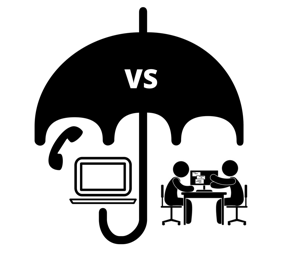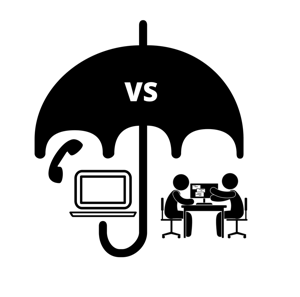
Mistakes People Make When Buying Insurance
Purchasing insurance is the most effective method to protect our families and ourselves, financially against unforeseen circumstances. Often however, people make simple mistakes whilst purchasing personal insurance cover. Here are some of the mistakes we find people make.
Purchasing insurance online or over the phone without professional advice
 This point refers to all those commercials you see on TV about how you can buy insurance cover over the phone in 5 minutes without any medical and lifestyle questionnaires. When you buy insurance over the phone or online, the assessment process will seem to be very simple and fast. This type of insurance is what we refer to as direct insurance. Although simple to implement, direct insurance comes with more risks as direct insurance cover can mean assessment is carried out at the time of claim.
This point refers to all those commercials you see on TV about how you can buy insurance cover over the phone in 5 minutes without any medical and lifestyle questionnaires. When you buy insurance over the phone or online, the assessment process will seem to be very simple and fast. This type of insurance is what we refer to as direct insurance. Although simple to implement, direct insurance comes with more risks as direct insurance cover can mean assessment is carried out at the time of claim.
For example you might call up an insurer that you’ve seen on TV and get your insurance cover in place. 3 years later you suffer from a medical condition and need to claim. As the assessment wasn’t carried out during the application stage, it’ll be carried out during the claim stage. During assessment process, the insurer will assess you medically and financially for both the claim and from when you started the policy. If the insurer discovers that you’ve had medical conditions prior to taking out the insurance policy, they could potentially void your claim altogether, meaning they cancel the policy as if you never held it. This ultimately means you have been paying 3 years’ worth of premiums for an insurance policy which provided you with no cover at all.
Going through professionals such as a financial adviser, should mean you’re assessed at the time of application. Although the process may take a little longer, it means you and your family have some certainty when you are accepted at application time, rather than be declined payment because of something you didn’t disclose during application stage.
Only considering price rather than value of the product(s) purchased
Price can often play an important part in your decision to buy personal insurance, but it should not be the only factor to consider. Find out about things like:
– Additional benefits and definitions of the policy
– What types of benefits are included and excluded
– Claims payment procedures
– What exclusions or limits exist on the cover
– Ownership options
Price should not be the only consideration when purchasing insurance. That good old saying of ‘You get what you pay for’ applies here. Cheap generally means a lesser policy.
Implementing the wrong levels of cover required
We often find many people implement insufficient insurance covers in order to save money on premiums or they simply don’t know what to include when assessing their need for cover. Whatever the case underinsurance could leave you and your family in financial strife.
These are just some of the questions you need ask yourself whilst implementing death cover.
If you were to die prematurely which option would you prefer for your partner?
– Repay the home loan and never have to work again
– Repay the home loan and not have to work for 5 years
– They lose the house and have to return to work immediately
– They can fend for themselves
Additionally would you also want the following expenses covered?
– Funds for funeral expenses, medical expenses and legal expenses
– Funds for the children’s education
– Funds as an inheritance for kids and your partner
– Purchasing insurance with premiums that increase as you get older
As you get older the chances of you suffering from a medical condition increases, therefore insurers tend to charge higher premiums for older Australians. This causes many people to cancel their cover simply because the premiums (costs) keep getting higher each year with their age.
You also have the option of purchasing your insurance with level premiums. This means the premium can be averaged over the lifetime of the policy and will not increase each year with your age (Cover and premiums can increase by CPI).
Another option is to reduce your sum insured which will reduce your premiums. As you get older, your expenses and debts such as the mortgage tend to reduce. Therefore you can reduce your level of insurance cover depending on your situation, which in turn will reduce the premiums payable.
Not reviewing your situation and your cover as life events take place
Certain events that occur in our lives can make a massive impact on our financial needs. Events can range from the birth of a baby to repaying the mortgage, receiving a promotion or re-entering the work force.
Every time there are certain changes to your life, you need to review your insurance cover. Picking up that phone and having a chat to your adviser, could mean you and your family receive the much needed additional cover. Or it could even mean savings in premiums as the existing cover you have may be too high and needs to be reduced. Whatever the case it’s important to review your insurance needs every time a certain life event occurs.
If you want to know more or thinking about putting in place personal insurance cover, please contact JBS Financial Strategists.









 A business generally depends on a few people to produce the profits, provide the capital, and manage the business. If there is no viable succession plan, there may be significant financial hardship for the surviving business owner(s), as well as for the surviving family members.
A business generally depends on a few people to produce the profits, provide the capital, and manage the business. If there is no viable succession plan, there may be significant financial hardship for the surviving business owner(s), as well as for the surviving family members.
 insurance one we prefer to avoid however is necessary. Most Aussie families would find it difficult and almost impossible to meet daily living expenses should the main income earner pass away. This often leads to families having to move back in with relatives, increasing debt levels and even losing the family home.
insurance one we prefer to avoid however is necessary. Most Aussie families would find it difficult and almost impossible to meet daily living expenses should the main income earner pass away. This often leads to families having to move back in with relatives, increasing debt levels and even losing the family home.




 nor private health insurance, yet when it comes to our health, there is no doubt you would want the best treatment available.
nor private health insurance, yet when it comes to our health, there is no doubt you would want the best treatment available.




